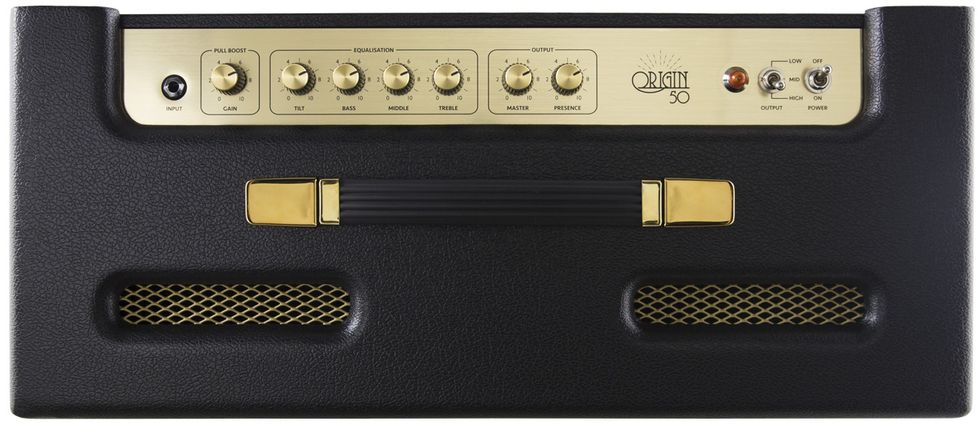RatingsPros:Excellent tones. Great with pedals. Solid construction. Useful tilt knob and low power modes. Cons: No reverb. No channel switching. Doesn’t quite sound like a vintage Marshall. Street: $799 Marshall Origin 50C blackbirdguitar.com | Tones: Ease of Use: Build/Design: Value: |
Marshall’s new Origin 50C is a budget-conscious 1x12 tube combo full of clever and useful modern features. Yet its controls are no more complex than the ones on a 1960s Marshall. It’s part of a new Origin line, which also offers lower-wattage combos and head-only models, including a 50-watt companion to the combo reviewed here.
You Get What You Need
According to Marshall’s marketing, the Origin series provides “what contemporary players want and need.” Yup, sounds like marketing. But guess what? It’s more or less true.
Specifically, this single-channel amp has a relatively neutral and wide-range tonal response, perfect for players who prefer to craft tones chiefly from their pedalboards. Lows are lower and highs are higher than on traditional Marshalls. Oh, there’s still plenty of Marshall roar, thanks to the classic recipe of two EL34 power tubes and a trio of ECC83 preamp tubes. You can summon many flavors of crunch with only a guitar and a cable, which is all you hear in the first demo clip. The dynamic response is excellent. You can crank the distortion, and then clean it up with a guitar volume knob.
But you can also get sparkling, treble-rich tones at relatively high volume. That’s perfect for players who design distortion via their favorite fuzzes and overdrives. For the second demo clip, I connected some homemade fuzz boxes and an Eventide H9 and scrolled through presets. (It’s the same knobs-at-noon clean tone throughout the clip. The distortion is pedal-only.) I certainly hear more detail in the H9’s hi-res effects than I would through a vintage amp. Reverbs are airier and octave-up pitch-shifts maintain their edge. Conversely, sub-octave transpositions have more thump and definition. The solid-state rectifier feels tighter and faster than the tube type, and high-gain tones have spitting presence. If a vintage Marshall and a hi-fi speaker cab had a baby, it might sound something like this.
Moves for Moderns
The Origin 50C runs at 50, 20, or 5 watts. There’s little tonal difference between settings. The 5-watt crunch is as tough as the 50-watt stuff.
There’s a boost stage, activated via a push/pull gain switch or the included foot pedal. A second footswitch toggles the mono/in-series effects loop in and out of the signal chain. That way, you can cue up complex effect combinations with your feet and activate them all at once, as opposed to fandango-ing all over your pedalboard every time you go from dry to wet.
Another clever idea: Marshall replaced the traditional bright switch with a “tilt” knob. This way, you can get subtler adjustments than maximum dark/bright. These in-between settings can be quite useful. I found myself leaving the tone controls near noon, and adjusting only the tilt knob when fine-tuning tones.
The amp is open-backed, but a secondary baffle encloses part of the speaker, projecting sound forward as in a closed-back cab. I can’t swear this is entirely due to the baffle, but the Origin 50C has the hefty bass thump of a sealed cabinet while dispersing sound in all directions like a Fender combo amp. It’s easy to capture beefy low-end via close miking. But when you play in small spaces, you probably won’t suffer the “closed-back curse” (deafening people across from you while barely hearing yourself).

Do these seem like useful features? Cool! You’re the player Marshall is aiming for. But if you don’t care about that stuff and just want to get as close to a vintage Marshall as possible at a reasonable price, the Origin line may not be your best avenue of pursuit.
Value Valves
The Origin 50C sells for a modest $799. (Compare that to Marshall’s current reissue of their two-power-tube JTM-45 combo, which goes for $2,700.) Obviously, Marshall is cutting some corners here, but they’re intelligently chosen cuts.
The amp is manufactured in Vietnam. Components are assembled on circuit board, which also hosts the jacks and pots. The cabinet is stout, but made from composite material. (The amp weighs 40 pounds.) Still, the Origin 50C sounds terrific, and there’s nothing flimsy about its hardware and cabinetry. The foot pedal is stage-worthy. This amp may be made with mass-production methods, but it’s well made. I wouldn’t hesitate to use it in the studio or take it on tour.
The Verdict
Much creative thinking went into Marshall’s Origin 50C. Its sound is partly rooted in vintage Marshall, but its relatively flat and full-frequency profile is perfect for pedalboard tone sculptors. You may rarely touch the bass, mid, treble, or presence knobs, because the tilt control might do everything you need. Tones are bold at all wattages. At $799, the Origin 50C is a big, big bargain.
Watch the First Look:









![Rig Rundown: Russian Circles’ Mike Sullivan [2025]](https://www.premierguitar.com/media-library/youtube.jpg?id=62303631&width=1245&height=700&quality=70&coordinates=0%2C0%2C0%2C0)

















